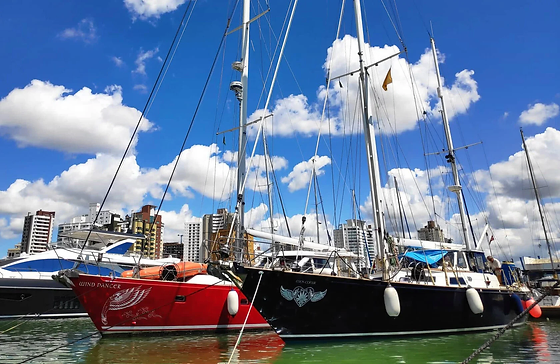
We manufacture Sailing Yacht for Sale for our customers in Europe, Australia, and the US. Check our website for more information about the sailing boats
As is well known the most common material for sailing yacht construction was, for many years, wood. Many yachts constructed of wood continue to survive thanks to the unique characteristic of this material, which allows easy repair. Due to this aspect, there are many masterpieces of yacht-building art sailing at sea. The word ‘art’ is suitable in this case because the construction procedure of a sailing yacht often relies on the skill of local workforces rather than on modern shipyard construction techniques.
With the application of new bonding products and procedures, coming from composite material production, wood is again utilized in the construction of innovative boats with laminated construction being allied to epoxy resins. Thanks to the elimination of mechanical joints and bolts/screws this technique produces very light shells, made stronger by the presence of epoxy resin. Sangermani Shipyards in Italy implemented this technique, studying the effect of carbon cloths inserted between layers of red cedar wood.
Sailing Yacht for Sale

The shipyard produced a 25 metre schooner, called Quarta Santa Maria, in 1995 and other smaller sailing yachts with the same technique. A further proof of the quality of this method is represented by the sailing yacht Sheherazade which, launched in 2003 from Hodgdon Yachts Shipyards on the coast of Maine, U.S.A. and having an overall length of 47.10 metres, is the largest yacht constructed in this manner.
The production of sailing yachts with steel and aluminium alloy is used for yachts of a large size, typically over 40 metres in length. It is possible to find some exceptions but, in general, these are represented by racing yachts (in aluminium) and training ships (in steel). The facilities and techniques used to construct such vessels are, in general, very similar to those employed for merchant ships and motor yachts, the only differences
being the hull shape and the stiffener sections.
It is important to underline that the biggest sailing yacht in the world EOS, a 92.9 metre Bermudan rigged schooner, was built in aluminium alloy by Lurssen Shipyards (Germany) in 2006. Another very large sailing yacht, Athena, launched by Royal Husman Shipyards in 2004, was also built in aluminium. For several years the largest steel sailing yachts have been built by Perini Navi, the 88 metre ‘Dynarig’ schooner Maltese Falcon launched in 2006 represents a significant example from this shipyard.
For normal yachts of a medium size and constructed from FRP composite materials the traditional procedure of laminating in a female open mould is still used by the majority of shipyards. For polyester/glass composites a normal hand or spray lay-up technique can be used. In a typical hand lay-up, reinforcements are laid into a mould and manually ‘wetted out’ using brushes, rollers, or through other means. The part is then cured, cooled and removed from the re-usable mould.
Manufacturing of Sailing Yacht for Sale
This production method is a very economical process and has a low investment; it can be used for complicated shaped pieces and the laminate thickness is adaptable. The disadvantages of hand lay-up are that the final quality depends heavily on the skill of the personnel and, because of its open mould nature, the effects on the local working environment are proven to be dangerous for human health. The fibreglass spray lay-up process is similar to the hand lay-up process but the difference lies in the application of the fibre and resin material to the mould.
Spray-up is an open-mould composites fabrication process where resin and reinforcements are sprayed into a mould. Workers ‘roll out’ the spray-up to compact the laminate. Wood, foam or other core materials may be added, and a secondary spray-up layer embeds the core between the laminates. The advantages of this production method are similar to those of hand lay-up. However, it is not suitable for making parts that have high structural requirements. It is also difficult to control the fibre volume fraction as well as the thickness, which highly depend on operator skill.
The process offers a good surface finish on one side and a rough surface finish on the other. The process is not suitable for parts where dimensional accuracy and process repeatability are prime concerns, and styrene emission is again a concern. An improvement on the hand lay-up method is to use a vacuum bag placed over the laminate, sealed around the edges to the mould and evacuated using a vacuum pump to force excess resin out of, and to consolidate the laminate.
However, this technique is normally used in conjunction with pre-preg laminates, where the fibres are preimpregnated with resin in a very controlled manner by the materials supplier. These materials must be kept refrigerated until they are placed on the mould and may be cured at elevated temperatures by the boat builder.
Resin infusion (RINa, 2006) builds upon these principles, providing further improvements to the lamination process. The technique uses vacuum pressure to drive resin into a laminate. Reinforcement materials are laid dry into the mould, covered with peel-plies, breather materials, vacuum distribution mediums and finally a vacuum bag and the vacuum is applied before resin is introduced. Once a complete vacuum is achieved, resin is sucked into the laminate via carefully placed tubing (Figure 10)
Materials for Sailing Yacht for Sale
‘Resin infusion’ is in fact a general term, and the process as used in yacht production, may also be correctly referred to as ‘Vacuum Infusion’ or ‘SCRIMP’ (a specific proprietary method). However, there is some confusion in terminology with Resin Transfer Molding, or ‘RTM’, (in which dry fibres are injected with resin under high pressure in a mould of very stiff male and female parts) and Vacuum Assisted Resin Transfer Moulding, or ‘VARTM’, (where RTM is assisted by a vacuum applied to the stiff mould prior to injection) somewhat erroneously being used to describe the resin infusion process used in boat building.
The production of composite yachts is moving rapidly towards these ‘closed-mould’ production techniques, especially resin infusion. This change is mainly driven by the fact that closed mould techniques can largely eliminate the undesirable working environment associated with hand lay-up and spray-up, a very important requirement given ever more stringent environmental regulations.
The other main advantage is the higher and less variable laminate quality achieved using infusion. For series production or large components infusion also results in lower costs, but for smaller, one-off products, and especially whilst gaining experience in the technique, cost savings are not large. The benefits of using the infusion process are:
- Greatly reduced emissions
- Better fiber-to-resin ratio
- Less wasted resin
- Very consistent resin usage
- Unlimited set-up time
- Cleaner working environment
- Ability to achieve from 0.5mm to 90mm laminate thickness
- Ability to mold complex structural and hollow shapes
- Uses only low pressure (molds do not have to be excessively stiff and existing molds may be used)
- Inserts may be incorporated into moldings
- Selective reinforcement and accurate fiber management is achievable
- Components will have a good surface finish on both sides (Professional
- Boatbuilder, 2008)
- Sandwich structures may be laminated in one hit.
- However, the infusion is not without its drawbacks and it is important to consider the following points:
- Complicated set-up: both vacuum tubes and resin inlet placement will be critical.
- Easy to ruin a part: typically once infusion begins it is difficult to correct any errors.
- Trial and error: due to the complexity and ease of error, resin infusion should be viewed as a trial-and-error process. The best approach is to carefully document each attempt in order to learn from each trial and to practice with small quantities and inexpensive materials before undertaking full-scale projects.
